#Robotron 2084
Explore tagged Tumblr posts
Text

508 notes
·
View notes
Text
Williams "Robotron 2084" arcade - attract mode
Reviewing Williams' "Robotron: 2084" from a deep philosophical perspective invites a fascinating exploration of the game's underlying themes, aesthetics, and the existential questions it raises, both intentionally and inadvertently.
1. Man vs. Machine - A Reflection on Technological Progress: "Robotron: 2084" centers around the classic theme of humanity's struggle against its own creations - the robots. Philosophically, this can be viewed as a commentary on the anxieties and paradoxes of technological advancement. As players fight against a relentless horde of machines, the game echoes fears of technology becoming uncontrollable or turning against its creators. This mirrors existential concerns about the role of technology in human life and its potential to both enhance and undermine the human experience.
2. The Individual vs. The Collective: The game's premise, where a single protagonist battles against an overwhelming collective force, touches on philosophical debates about individualism versus collectivism. The player's lone character, constantly battling overwhelming odds, can be seen as a metaphor for the individual's struggle to maintain identity and autonomy in the face of societal or technological collectives that threaten to subsume individuality.
3. The Sisyphean Struggle and Absurdism: "Robotron: 2084" offers no end, only an ongoing battle against an endless stream of enemies. This can be philosophically interpreted through the lens of Albert Camus' concept of the absurd hero, akin to Sisyphus' eternal struggle. The game's never-ending nature and the player's inevitable defeat reflect the absurdity of life and the idea that meaning and value come from struggle itself, rather than any final victory or conclusion.
4. Ethical Implications of Artificial Intelligence: On a more contemporary note, "Robotron: 2084" raises ethical questions about artificial intelligence and its implications for humanity. The robots, originally designed to serve humans but now their adversaries, symbolize the ethical dilemmas and potential dangers associated with AI. This aspect of the game prompts philosophical inquiry into the responsibilities of creators towards their creations and the ethical limits of artificial intelligence.
5. Nostalgia and the Human Psyche: From a more psychological perspective, the game's retro style and enduring popularity can be seen as an embodiment of nostalgia and a longing for simpler times. This raises questions about the human tendency to idealize the past and whether such nostalgia is a comforting escape or a barrier to confronting current realities.
6. Aesthetics and the Nature of Video Games as Art: "Robotron: 2084," with its distinctive 1980s arcade graphics and sound, contributes to the philosophical discussion about video games as a form of art. The game's style, gameplay, and enduring appeal challenge traditional notions of what constitutes artistic merit and invite players to consider the artistic value inherent in game design and the interactive experience.
In conclusion, "Robotron: 2084," while ostensibly a simple arcade game, offers rich material for philosophical exploration. Themes of man versus machine, individual versus collective, the absurdity of endless struggle, ethical considerations of AI, the role of nostalgia, and the nature of video games as art all converge in this classic game, demonstrating the profound potential for video games to engage with deep philosophical concepts and questions.
24 notes
·
View notes
Text
Robotron: 2084 - Featured in our book - Atari 2600/7800: a visual compendium - Coming Soon 📚
At 528 pages, Atari 2600/7800: a visual compendium provides an exhaustive overview of Atari’s iconic games machines. With dozens of articles and interviews, and featuring more than 200 games, it’s a must-have for Atari fans and collectors alike.
Reprints are due in November 🕹️
Get an email reminder here: https://www.bitmapbooks.com/collections/all-books/products/atari-2600-7800-a-visual-compendium
#bitmapbooks #book #retrogaming #retrogames #gaming #art #reading #foryou #asmr #bookstagram #booktok #atari #comingsoon #fyp #robotron2084
2 notes
·
View notes
Text
037: Satryn
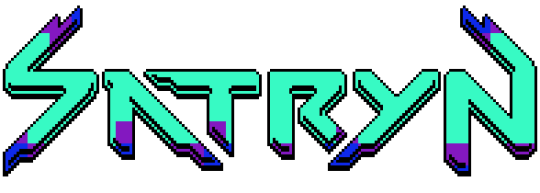
A deliberate homage to Eugene Jarvis and Larry DeMar’s Robotron: 2084, Satryn initially feels almost too faithful to the original. It’s that close imitation that makes the differences starker, turning it into a companion that draws into focus how little aesthetic choices can drastically alter the feeling of what initially seem to be simple games.
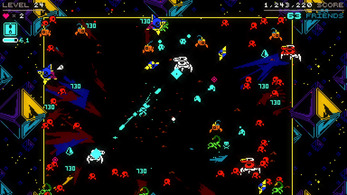
Instead of modern analog movement and aiming, Satryn uses strictly digital 8 way movement and shooting. It goes against the assumptions of the modern twin stick shooter, but what it loses in finesse it gains in precision and readability. A similar philosophy drives the visuals. Backgrounds are stark black fields, with enemies coming in high contrast colors and silhouettes, making it simple to discern them at a glance. Each enemy has a distinct behavior, and a smart player will quickly learn which ones to prioritize.
Dotted among the hazards and enemies are Friends, small smiling creatures who you’re here to save from their banishment. Each friend saved gives a small boost to your score multiplier, which becomes important not only for scoring, but survival, since a random powerup will be generated at certain score intervals. These range in usefulness, from bursts that push enemies away, to adding directional coverage, fire speed, or giving you a shield that allows you to take an extra hit.
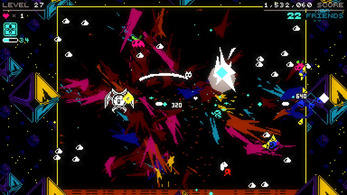
Satryn demands a certain amount of adaptability, since powerups, hazard and enemy placements are randomized every run, keeping you from memorizing stages or developing repeat strategies. It generally works in the game’s favor, since the score based focus and lack of ending keeps it replayable. It’s only occasionally an issue where the random generation can cause wild swings in difficulty, with certain enemy combinations being overwhelming, or the random nature of shield bonuses essentially giving you an extra life through sheer luck.
It’s also worth giving special attention to the soundscape. Satryn has no background music, instead the atmosphere is made entirely of the arpeggiated synth sound effects, and cold hum of this prison planet. There’s a surprisingly detailed use of directional audio, too, with the sounds of enemies and explosions tracking across stereo channels, adding to paranoia with a sense of danger approaching on all sides.

This reaches a crescendo after you’ve lasted a few waves, where the diamond shaped Wardens that have previously watched from the game marquee enter the playing field. An audio countdown is initiated, before they burst from the sidelines and drop into the arena, approaching with their intimidating size and multiple layers of armor that need to be dismantled before attacking their core. It’s a terrifying reversal of expectations that suddenly projects another layer of uneasiness into future runs. What you previously believed to be a decorative element were actually sentient beings, observing you and deciding when they need to step in.
Taken with the background fiction and enemy profiles gradually unlocked in the in-game manual, it provides an interesting subtext to the story, especially when compared to the fiction set up by the original Robotron. Robotron had you playing as a superhuman, the result of a genetic engineering error, saving members of the last surviving human families from an army of robots whose calculations have shown that humanity is its own greatest threat, with the only way to protect humanity being its destruction. The last human family has distinct roles of father, mother and child that mirror a stereotypical nuclear family.

By contrast Satryn’s protagonist, the Former, and the friends you save are considered Invalids, tossed onto the prison planet of Satryn to be disposed of by the creatures in its ecosystem. While Robotron draws on sci fi works like 1984, and fears of technology making human life obsolete, and disrupting the nuclear family, there’s an almost queer subtext to Satryn. Robotron’s menace is artificial, cold and calculating, while Satryn’s enemies are very much organic, splattering into streaks of color with each shot, reproducing and leaving traces of themselves in the arena’s aftermath.
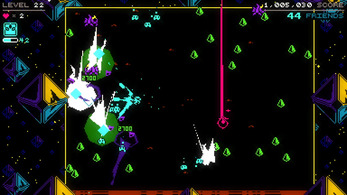
There’s malice in Satryn’s fiction, where extinction comes not from machine logic, but systematic exile and extermination. Satryn’s Wardens have sent you and your friends to this planet to watch you die, and they step in when they’ve decided it���s taking too long to happen. Intentionally or not, Robotron carries heteronormative assumptions about what the family looks like, with an inherent optimism that the same technological faults that bring upon our destruction can enable us to resist against it. Satryn’s Former is instead exiled by their genetic defects, using the powers granted by it to protect their friends. Even the name feels loaded, with the Former pointing to their status as an ex-human, someone who used to belong to society, or someone who underwent a great change.
Maybe that’s projection on my part, but there’s something about the fiction of Satryn that resonates with me. Robotron was painted in the colors of kitsch, the fiction little more than a backdrop for action unfolding. And still it came with assumptions about what the future looked like, and what was worth protecting. Decades later Satryn has provided a companion piece that, intentionally or not, reexamines those assumptions.
Satryn is available for free on itch.io and Android. A "Deluxe" version is available on Steam with online leaderboards.
3 notes
·
View notes
Text
Retro Gaming: Robotron 2084
The year was 1982. An actor was President in America, An Extra-Terrestrial reigned supreme at the box office, and the Go-Go’s made history being the only all-female band to chart who played their own instruments. I don’t really know if times were good or bad because I was nine years old. Those eyes hadn’t seen enough yet to select a proper basis of comparison. As a nine year old, the world kicked…
0 notes
Text
youtube
True to my word, here's the version with the controls I wished I had back in the 80s. While it remains a challenging game, this version gives you a real sense of control and accountability; there's no room for excuses if you run out of lives. And let me tell you, taking down those robo-enemies is an absolute blast!
#retro gaming#retro gamer#retro games#video games#gaming#old school gaming#back to the past#I want to go back#those were the days#good old days#midway's greatest arcade hits#robotron 2084#gba#game boy advance#shooter games#classic games#love gaming#gaming life#gamer guy#gaming community#Youtube
1 note
·
View note
Text

Robotron 2084 by Cleo-Peronei
14 notes
·
View notes
Video
youtube
Zeddytron 2081 for the ZX81
#youtube#Zeddytron 2081#Zeddytron#ZX81#Action#Shooter#Robotron 2084 Clone#Robotron Clone#Homebrew#Homebrew Game#Naranjito Games#Cronosoft
2 notes
·
View notes
Text

Robotron: 2084 (Atari 5200) //Discord// //Twitch// //Ko-Fi//
26 notes
·
View notes
Text
Nintendo Game Cube - P.N. 03
Title: P.N. 03
Developer/Publisher: Capcom
Release date: 27 March 2003
Catalogue Code: DOL-GPNJ-JPN
Genre: Action Shooter
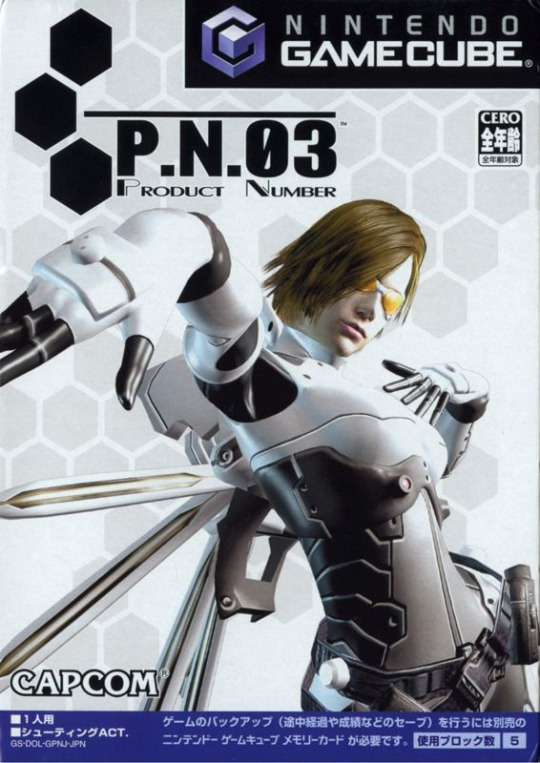

PN03 is a solid arcade-style shooter set in cool, slick, sci-fi environments. It's short on story for a reason - it's just a lady who loves dancing to techno beats and blowing up robots! Who needs a story? You run around, adapt to the evolving AI, blast robots, and - congratulations! - go to the next level of running around and adapting to the evolving AI and blasting robots. It's the kind of heart-pounding, adrenaline-pumping action that made such classics as Berzerk and Galaxian/Galaga and Robotron 2084 and countless others into, well, classics! Add the nice graphics power of the GameCube with its beautifully cold environments and the lovely toe-tapping heroine, and you've got a, well, classic! The most common gripe about PN03 is repetition. Yes, it is repetitive, but not in a bad way. When you get into a room that is familiar in layout, you think "ah! I've been here before... I know exactly what to do!"... and then something new happens! The repetition of rooms is there to make you hone your skills, not to be cheap. Need I say it again? It's just a fun shooter! Just shoot and have fun!
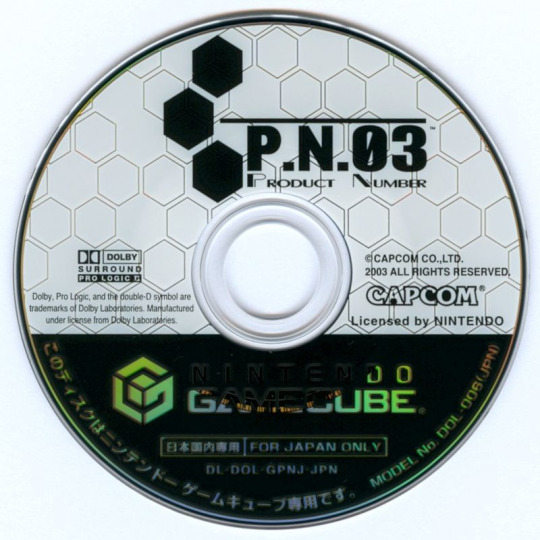
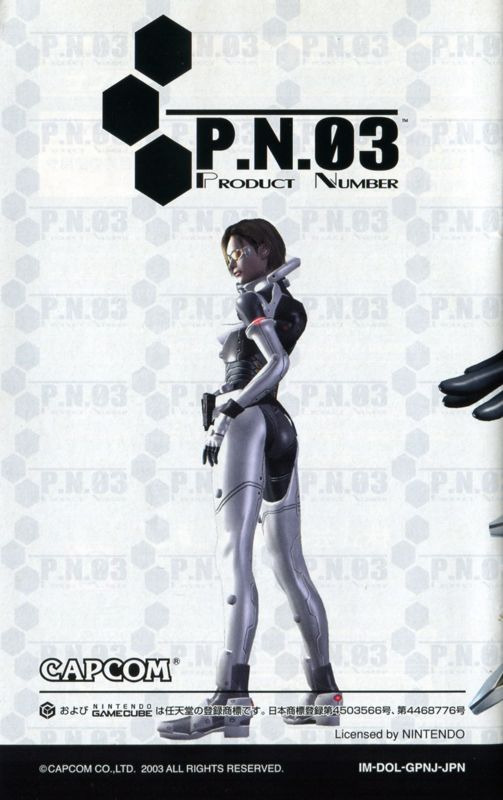
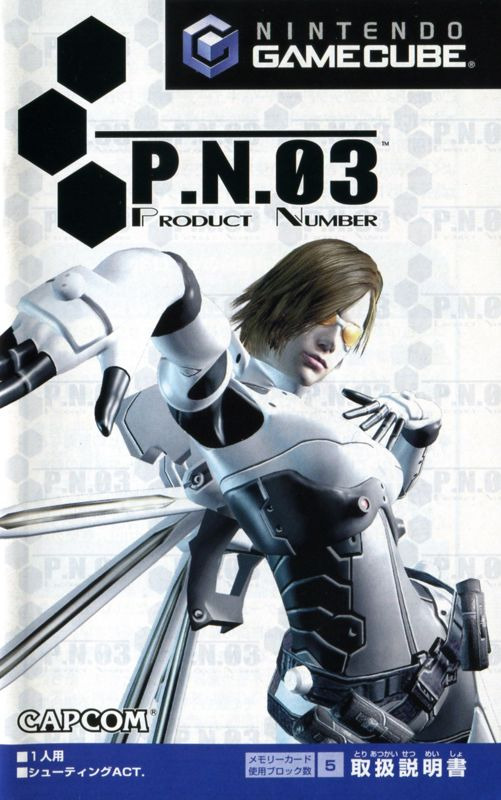
youtube
4 notes
·
View notes
Text
The most iconic arcade game that spark the gaming industry was Williams Defender
Back in the coinops days in the 80s
E. Jarvis made a very impact on the Arcade gaming industry of Williams Electronics
And other well known games from Williams Electronics are
Robotron 2084
Joust
Sinistar
Bubbles
Splat
And many more that Williams produced

3 notes
·
View notes
Text


Wizard of Wor
Developed/Published by: Dave Nutting Associates / Midway Released: 5/06/1981 Completed: n/a Completion: Played it a bunch? Version Played: Midway Arcade Origins
The Xbox 360 marketplace is dead.
Now, I know that’s a strange way to begin an article about an arcade game from 1982, but it’s the reason why I played it. With Microsoft shuttering its Xbox 360-specific digital storefront, I was driven to pick up any games that I hadn’t made a point of picking up already, and was surprised to find a couple of things. Firstly, that the Xbox 360 was, for me, largely a system I played before ever starting writing this project, and secondly I probably had about everything I ever wanted for it, bar things that I wasn’t willing to shell out for–and in many cases, those would remain backwards compatible on Xbox One/Xbox Series, which means that if I was desperate to play them I could buy an Xbox One for probably cheaper than you can get a 360 now.
What this meant, ultimately, was that I ended up going completely off piste and buying a Kinect for $10 so I could make sure to download a bunch of “Kinect Labs” games before they became totally inaccessible, but while I was doing that I realised I was unclear if I bought anything on the backwards compatible store after the old marketplace shut down if I could get it on my Xbox, so just in case I picked up Midway Arcade Origins, which, shockingly, is the latest collection to feature some of the greatest games of all time–Defender, Robotron 2084, you know what I’m talking about–and it came out in 2012!
It seemed worth a fiver.
Now, to quickly capsule review it: it’s… barely worth a fiver. It comes from the most bare-bones era of collections, with no filters or anything (though don’t forget you can run an Xbox 360 on a CRT. I did, for years) and to be honest I’m not sure about how good the emulation actually is. I also forgot that the Xbox 360 d-pad is absolute bobbins.
But no matter. I have it now, so I thought I’d play Wizard of Wor.
Designed by Dave Nutting Associates, whom I last had a run in with discussing their version of Taito’s Western Gun in exp. 2601, Wizard of Wor is a game that made me realise that I was probably a little harsh on 1978’s Fire Truck, because this is probably only the second co-op action game ever–and it’s a shooter. I mean Dave Nutting and Tom McHugh basically made Doom here.
Well, sort of. Really, Wizard of Wor exists in the context of Berzerk, which is really the first sort of hint to what games would eventually become. Designed by Alan McNeil, himself once a Dave Nutting Associates employee, in Berzerk you run around randomly-generated screens shooting robots and trying to avoid “Evil Otto” who appears if you dally too long. There’s no much to it, but it featured a synthesised speech chip telling arcade patrons it had “detected” coins in their pocket, and was suitably different from the more restricted, focused play in Pac-Man or Galaxian.
I suspect–though look, I’m just hypothesising–that Dave Nutting Associates felt they couldn’t take an ex-employee creating a hit lying down, and decided to do them one better, with Wizard of Wor similar in some respects but with more graphics, more monsters, more design, more speech (and good lord does it never shut up–though it’s hard to actually understand compared to Berzerk) and even co-op play.
Although fondly remembered, Wizard of Wor is… clumsy–and it’s not just that player one starts on the right. Taking Bezerk’s play but crushing it into a Pac-Man like maze with large graphics mean there isn’t a ton of room for manoeuvre, and trying to move your “worrior” into position–or even just around corners–is honestly rather frustrating. Enemies move around randomly and you don’t want to walk into them, and while the game (strangely) has a “bump” mechanic where if you are “between” spaces as you move into enemies you bump back, you end up having to turn corners, head away from enemies, and only then turn around to shoot them, and it’s slow.
The trick, really, is that the game doesn’t really work unless you’re playing it in two-player. While you can accidentally kill each other, the trick is to constantly play with your back to each other meaning that, technically, you should never be caught unawares. But there’s actually another little trick to the game–it features line-of-sight on all but the weakest enemies, meaning you have to rely on an on-screen radar, making doing things like turning corners even more dangerous (and annoying), so even then you aren’t completely safe.
The goal–such as there is one–is to clear each screen and when possible kill the bonus “worluk” creatures who grant you double score on the next screen, and keep that chain going, accepting that certain screens (“The Pit” which has no walls) and rare appearances from the Wizard of Wor (who teleports around) will act as harsh skill checks for even well coordinated co-op players.
The thing about Wizard of Wor is that it’s… fine. It’s just simple enough to make you want to play it more, but it’s also just annoying enough to make you want to stop. It’s very close to something great, but it would Eugene Jarvis who would get there, taking Berzerk to the next level truly with Robotron 2084 just a year later.
Will I ever play it again? That all said, if you see this in the arcades it’ll be a jolly old time in co-op if you can find someone dedicated to trying for a high score with you.
Final Thought: A weird thing about Dave Nutting is that not only is this huge name in the early days of arcade games, he also designed the Jeep Wagoneer, so is in some respects at fault for the rise of the SUV and global warming by creating a car that literally got eleven miles to the gallon.
Hmm. Seems bad!
Support Every Game I’ve Finished on ko-fi! You can pick up digital copies of exp., a zine featuring all-exclusive writing at my shop, or join as a supporter at just $1 a month and get articles like this a week early.
#gaming#video games#games#txt#text#review#arcade#wizard of wor#1981#dave nutting associates#dave nutting#midway
3 notes
·
View notes
Text
then again... maybe some kind of simple top down mostly shooty kind of thing should be fairly straightforward. Maybe like Mashing up Llamatron 2112 (/Robotron 2084) with Vampire Survivors or something maybe for just loads of simple pixel stuff on the screen at once with relatively simple backdrops.
Could easily make the player entity some kind of customizable mech or space ship or something with different sort of firing arcs or movement profiles or the like depending on type or locomotion or whatever.
Should involve relatively few and simple art assets with a relatively simple gameplay loop while still being potentially interesting - at least from a starting point, anyway...
4 notes
·
View notes
Text
youtube
Allow me to add a different perspective to the conversation: Robotron: 2084 is undeniably a gem, boasting a fantastic concept, engaging gameplay, and a challenge that keeps you on the edge. It's the epitome of a classic shooter—packed with all the right ingredients. However, let's address the elephant in the room: the control system. For me, this aspect falls short and significantly impacts the overall experience.
I appreciate the developers' efforts in crafting such a captivating game, but the control scheme, to put it bluntly, undermines the gameplay. The Atari 7800 version, in particular, takes an unfortunate turn.
The decision to limit the lone hero's ability to shoot only while in motion feels restricting and complicates the gameplay dynamics. In instances where you're cornered, the inability to fire while standing still becomes an insurmountable challenge.
In my opinion the arcade version's two-joystick control scheme - where one stick dictates shooting direction - was already contentious (no, not a fan of this system, sorry). Nonetheless, the Atari 7800's implementation makes me miss it.
The necessity to constantly move to shoot creates predicaments where losing a life seems inevitable— again, pinned against a wall with enemies closing in, forcing movement to shoot, is a precarious situation with no recourse.
I don't intend to detract from the game's overall quality, but this control limitation impacts the gameplay significantly. Interestingly, the GBA version, part of Midway's collection, offers a different control system, presenting an alternative experience I'm eager to share when I upload such a video.
#retro gaming#retro gamer#retro games#video games#gaming#old school gaming#back to the past#I want to go back#those were the days#good old days#atari 7800#robotron 2084#shooter games#classic games#love gaming#gaming life#gamer for ever#gamer for life#console gaming#gaming nostalgia#Youtube
1 note
·
View note
Text

Robotron: 2084 Brain by The Artcade
5 notes
·
View notes